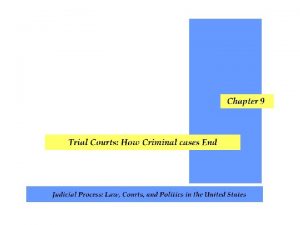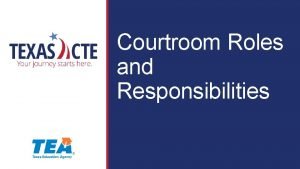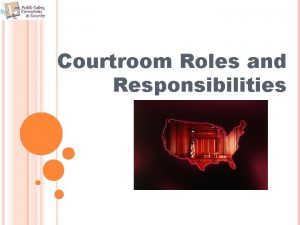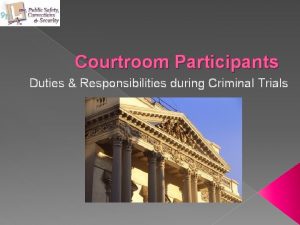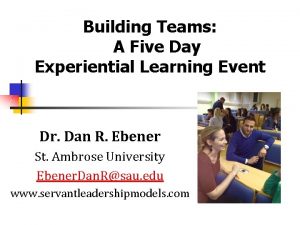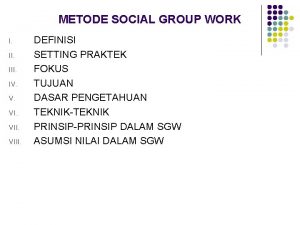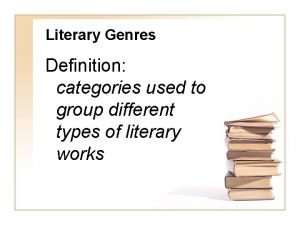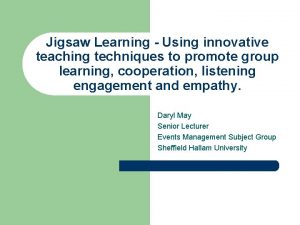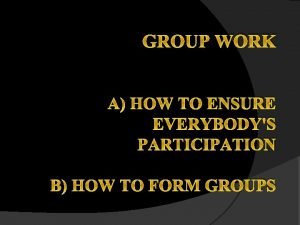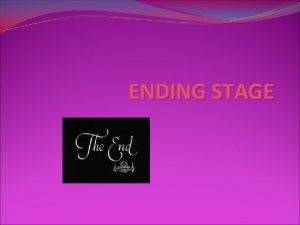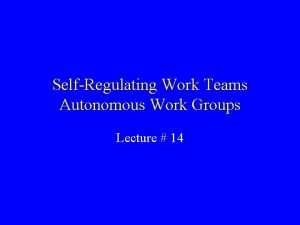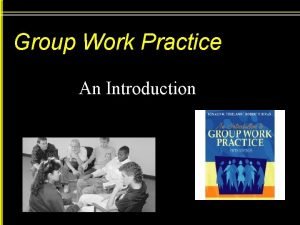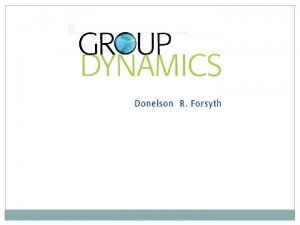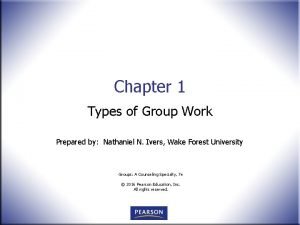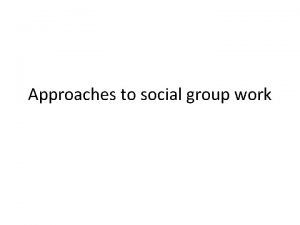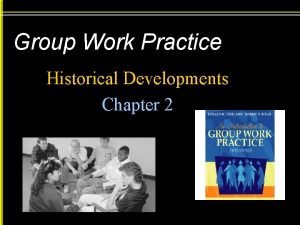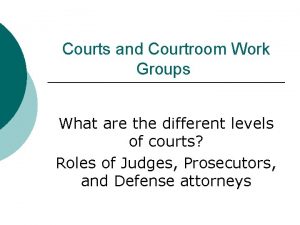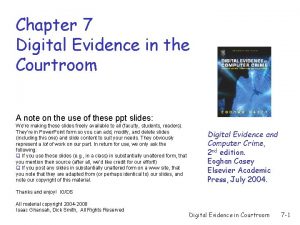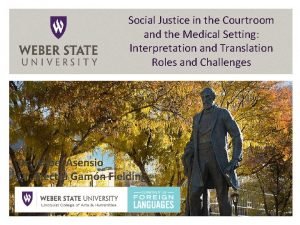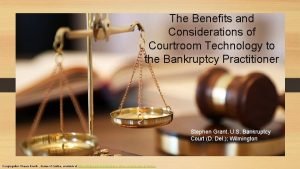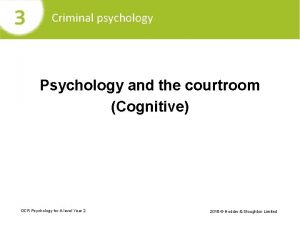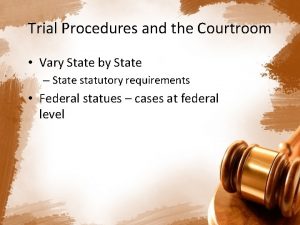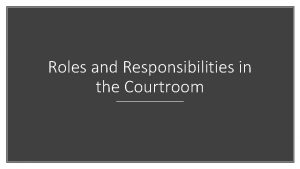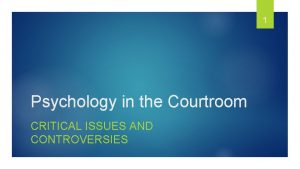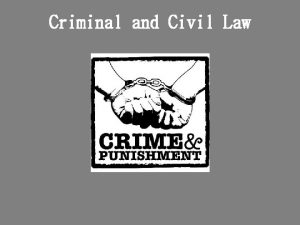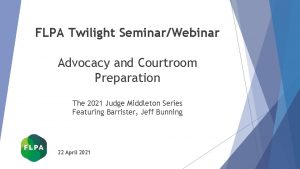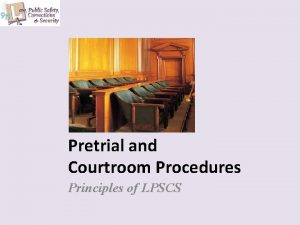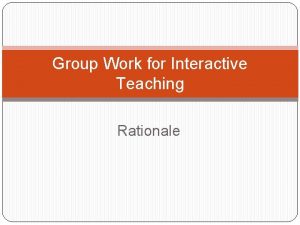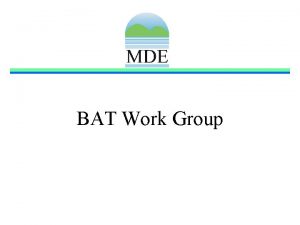CHAPTER 8 The Courtroom Work Group and the
















































































- Slides: 80

CHAPTER 8 The Courtroom Work Group and the Criminal Trial Criminal Justice: A Brief Introduction, 7 E by Frank Schmalleger © Prentice Hall 2008 Pearson Education, Inc Upper Saddle River, NJ 07458 1

The Courtroom Work Group: Professional Courtroom Actors Criminal Justice: A Brief Introduction, 7 E by Frank Schmalleger © Prentice Hall 2008 Pearson Education, Inc Upper Saddle River, NJ 07458 2

Courtroom Participants Professional (the courtroom workgroup) § Judge § Prosecuting attorney § Defense attorney § Bailiff § Court reporter § Clerk of the court § Expert witnesses Criminal Justice: A Brief Introduction, 7 E by Frank Schmalleger Non-Professional § Lay witnesses § Jurors § Defendant § Victim § Spectators § Press © Prentice Hall 2008 Pearson Education, Inc Upper Saddle River, NJ 07458 3

The Judge Primary duty to ensure justice Responsibilities include: § Ruling on most matters of the law § Weighing objections § Deciding the admissibility of evidence § Sentencing offenders § Disciplining disorderly courtroom attendees § Deciding guilt or innocence (for bench trials) Criminal Justice: A Brief Introduction, 7 E by Frank Schmalleger © Prentice Hall 2008 Pearson Education, Inc Upper Saddle River, NJ 07458 4

The Judge The chief judge handles administrative responsibilities if there is no court administrator. The chief judge: Hires staff § Ensures adequate training of new judges and staff § Generally manages court operations § Criminal Justice: A Brief Introduction, 7 E by Frank Schmalleger © Prentice Hall 2008 Pearson Education, Inc Upper Saddle River, NJ 07458 5

Judicial Selection Federal Judges State Judges § Nominated by President § Confirmed by senate § Popular election § Gubernatorial appointment § Missouri Plan (combines appointment and election) Criminal Justice: A Brief Introduction, 7 E by Frank Schmalleger © Prentice Hall 2008 Pearson Education, Inc Upper Saddle River, NJ 07458 6

Missouri Plan § Non-partisan committee creates a list of possible candidates. § The governor appoints from the list. § After a specified time period, the appointed judge stands for election. Criminal Justice: A Brief Introduction, 7 E by Frank Schmalleger © Prentice Hall 2008 Pearson Education, Inc Upper Saddle River, NJ 07458 7

Judges: Qualifications At general and appellate levels, judges must: § Be a member of the state bar § Be a licensed attorney § Hold a law degree (in most states) § Attend professional training In some lower courts, judges may be elected without educational or other professional requirements. Criminal Justice: A Brief Introduction, 7 E by Frank Schmalleger © Prentice Hall 2008 Pearson Education, Inc Upper Saddle River, NJ 07458 8

Prosecuting Attorney Prosecutors are also referred to as: solicitor, district attorney, state’s attorney, county attorney, or commonwealth attorney. Federal prosecutors are called U. S. Attorneys. Criminal Justice: A Brief Introduction, 7 E by Frank Schmalleger © Prentice Hall 2008 Pearson Education, Inc Upper Saddle River, NJ 07458 9

Prosecutors can be elected or appointed. § All but five states elect prosecutors. Prosecutors are elected for four-year terms. § Five states and the federal government appoint their prosecutors. Criminal Justice: A Brief Introduction, 7 E by Frank Schmalleger © Prentice Hall 2008 Pearson Education, Inc Upper Saddle River, NJ 07458 10

Prosecutor’s Responsibilities § Present the state’s case against the defendant § State has the burden of proof § Supervise staff of assistant district attorneys § Serve as quasi-legal advisor to police § Files appeals on behalf of the state § Makes presentations to parole boards Criminal Justice: A Brief Introduction, 7 E by Frank Schmalleger © Prentice Hall 2008 Pearson Education, Inc Upper Saddle River, NJ 07458 11

Prosecutorial Discretion …decision-making power, based on the wide range of choices available to them. Criminal Justice: A Brief Introduction, 7 E by Frank Schmalleger © Prentice Hall 2008 Pearson Education, Inc Upper Saddle River, NJ 07458 12

Prosecutorial Discretion Prosecutor decides: § Whether or not to charge someone with a crime § Which charges are to be filed against the defendant § Whether multiple charges should be filed together or separately § When to schedule cases for trial § Whether or not to accept a negotiated plea § What evidence to present, including witnesses § What sentencing recommendations to make Criminal Justice: A Brief Introduction, 7 E by Frank Schmalleger © Prentice Hall 2008 Pearson Education, Inc Upper Saddle River, NJ 07458 13

Disclosure of Evidence Brady v. Maryland (1963) The U. S. Supreme Court held that the prosecution is required to disclose to the defense any exculpatory evidence in its possession that directly or indirectly relates to claims of either guilt or innocence. Criminal Justice: A Brief Introduction, 7 E by Frank Schmalleger © Prentice Hall 2008 Pearson Education, Inc Upper Saddle River, NJ 07458 14

Disclosure of Evidence U. S. v. Bagley (1985) The Court ruled that the prosecution must disclose any evidence in its possession that the defense requests. To withhold evidence, even when it does not directly relate to issues of guilt or innocence, may mislead the defense into thinking that such evidence does not exist. Criminal Justice: A Brief Introduction, 7 E by Frank Schmalleger © Prentice Hall 2008 Pearson Education, Inc Upper Saddle River, NJ 07458 15

Prosecutorial Liability Imbler v. Patchman (1976) “State prosecutors are absolutely immune from liability…for their conduct in initiating a prosecution and in presenting a State’s case. ” Burns v. Reed (1991) A “state prosecuting attorney is absolutely immune from liability for damages…for participating in a probable cause hearing, but not for giving legal advice to the police. ” Criminal Justice: A Brief Introduction, 7 E by Frank Schmalleger © Prentice Hall 2008 Pearson Education, Inc Upper Saddle River, NJ 07458 16

Abuse of Discretion Prosecutors may abuse their discretion by § Not prosecuting friends § Accepting guilty pleas or reduced charges for personal consideration § Overzealous prosecution to gain visibility for possible re-election § Scheduling activities to make life difficult for defendants, in an attempt to put pressure on them to plead guilty § Discrimination against minorities § Withholding exculpatory evidence Criminal Justice: A Brief Introduction, 7 E by Frank Schmalleger © Prentice Hall 2008 Pearson Education, Inc Upper Saddle River, NJ 07458 17

The Prosecutor’s Professional Responsibility Prosecutors are expected to abide by various standards of professional responsibility, such as those found in the American Bar Association (ABA) Model Rules of Professional Standards. Prosecutors are barred from advocating any fact or position they know is untrue. Criminal Justice: A Brief Introduction, 7 E by Frank Schmalleger © Prentice Hall 2008 Pearson Education, Inc Upper Saddle River, NJ 07458 18

Defense Counsel The defense counsel is a lawyer who: § Represents the accused § Participates in plea negotiations § Prepares a defense § Calls witnesses § Refutes cases presented by prosecutor § Presents arguments at time of sentencing § Files appeals Criminal Justice: A Brief Introduction, 7 E by Frank Schmalleger © Prentice Hall 2008 Pearson Education, Inc Upper Saddle River, NJ 07458 19

Three Major Categories of Defense Counsel 1. Private attorney (retained counsel) w. Have their own legal practices or work for law firms w. Fees can be high 2. Court-assigned counsel (assigned counsel) 3. Public defender w. Lawyers drawn from a roster of all practicing attorneys w. Fees are paid at a rate set by the government w. Relies on full-time salaried government staff Criminal Justice: A Brief Introduction, 7 E by Frank Schmalleger © Prentice Hall 2008 Pearson Education, Inc Upper Saddle River, NJ 07458 20

Criminal Defense of the Poor The Sixth Amendment to the U. S. Constitution guarantees criminal defendants the effective assistance of counsel. Defendants who are unable to pay for private defense attorneys will receive adequate representation at all stages of criminal justice processing. Criminal Justice: A Brief Introduction, 7 E by Frank Schmalleger © Prentice Hall 2008 Pearson Education, Inc Upper Saddle River, NJ 07458 21

Powell v. Alabama (1932) The Court required that states provide defense counsel for those defendants who are unable to employ their own counsel and are charged with a capital offense. Criminal Justice: A Brief Introduction, 7 E by Frank Schmalleger © Prentice Hall 2008 Pearson Education, Inc Upper Saddle River, NJ 07458 22

Johnson v. Zerbst (1938) The U. S. Supreme Court established the right of indigent offenders to have legal counsel appointed for them in all federal cases. Criminal Justice: A Brief Introduction, 7 E by Frank Schmalleger © Prentice Hall 2008 Pearson Education, Inc Upper Saddle River, NJ 07458 23

Gideon v. Wainwright (1963) This case extended the right to appointed counsel for indigents in all felony cases. Criminal Justice: A Brief Introduction, 7 E by Frank Schmalleger © Prentice Hall 2008 Pearson Education, Inc Upper Saddle River, NJ 07458 24

Argersinger v. Hamlin (1972) The U. S. Supreme Court extended the right of indigent offenders to have legal representation in any case where they could lose their liberty (including misdemeanor cases). Criminal Justice: A Brief Introduction, 7 E by Frank Schmalleger © Prentice Hall 2008 Pearson Education, Inc Upper Saddle River, NJ 07458 25

In re Gault (1967) The U. S. Supreme Court extended the right to legal counsel for juveniles charged with a delinquent act. Criminal Justice: A Brief Introduction, 7 E by Frank Schmalleger © Prentice Hall 2008 Pearson Education, Inc Upper Saddle River, NJ 07458 26

Alabama v. Shelton (2002) Defendants in state courts who are facing relatively minor charges must be provided with an attorney at government expense even when they face only the slightest chance of incarceration. Criminal Justice: A Brief Introduction, 7 E by Frank Schmalleger © Prentice Hall 2008 Pearson Education, Inc Upper Saddle River, NJ 07458 27

Criminal Defense of the Poor Three Types of Programs 1. Court-assigned counsel 2. Public defender 3. Contract attorney Criminal Justice: A Brief Introduction, 7 E by Frank Schmalleger © Prentice Hall 2008 Pearson Education, Inc Upper Saddle River, NJ 07458 28

Court-Assigned Counsel § Fee paid based on state rate (most widely used). § Fee is usually low, raising questions about the level of commitment of defense attorneys. § Roster of local attorneys who are willing to take cases under established fees. Criminal Justice: A Brief Introduction, 7 E by Frank Schmalleger © Prentice Hall 2008 Pearson Education, Inc Upper Saddle River, NJ 07458 29

Public Defender Program § Uses full-time salaried attorneys. § 28% of counties nationwide use this system exclusively. § 64% of counties nationwide use public defenders as part of their system. Criminal Justice: A Brief Introduction, 7 E by Frank Schmalleger © Prentice Hall 2008 Pearson Education, Inc Upper Saddle River, NJ 07458 30

Contract Attorneys § Local attorneys are maintained on contract to handle all cases. § This is the least widely used form of indigent defense. Criminal Justice: A Brief Introduction, 7 E by Frank Schmalleger © Prentice Hall 2008 Pearson Education, Inc Upper Saddle River, NJ 07458 31

Criticisms of Indigent Defense System Criticisms relate to funding, caseload, and quality of defense. Criminal Justice: A Brief Introduction, 7 E by Frank Schmalleger © Prentice Hall 2008 Pearson Education, Inc Upper Saddle River, NJ 07458 32

Waiving the Right to an Attorney § 1% of federally charged defendants and 3% of state level defendants represent themselves. § Faretta v. California (1975) § Indigents are not required to accept counsel. They may waive their right and represent themselves. Criminal Justice: A Brief Introduction, 7 E by Frank Schmalleger © Prentice Hall 2008 Pearson Education, Inc Upper Saddle River, NJ 07458 33

Requesting a Different Attorney Defendants who are not pleased with their provided lawyer can request a new one, but the court must determine that there is a “clear reason” for reassignment. Criminal Justice: A Brief Introduction, 7 E by Frank Schmalleger © Prentice Hall 2008 Pearson Education, Inc Upper Saddle River, NJ 07458 34

Appeals and Indigent Defense State-supported indigent defense systems may also be called on to provide representation during appeals. If an attorney believes that such an appeal would be frivolous, he or she can request to be withdrawn from the case. Criminal Justice: A Brief Introduction, 7 E by Frank Schmalleger © Prentice Hall 2008 Pearson Education, Inc Upper Saddle River, NJ 07458 35

The Ethics of Defense ABA Ethical Guidelines § Canons of Professional Ethics § Model Code of Professional Responsibility § Model Rules of Professional Conduct § Standards for Criminal Justice: A Brief Introduction, 7 E by Frank Schmalleger © Prentice Hall 2008 Pearson Education, Inc Upper Saddle River, NJ 07458 36

Bailiff The bailiff is a law enforcement officer who: § Ensures order in the courtroom § Announces the judge’s entry § Calls witnesses § Maintains control over the defendant if the person has not been released on bail § Maintains physical custody of and supervises jury during deliberations and sequestering Criminal Justice: A Brief Introduction, 7 E by Frank Schmalleger © Prentice Hall 2008 Pearson Education, Inc Upper Saddle River, NJ 07458 37

Local Court Administrators Many states employ court administrators: § Facilitate the smooth running of courts in particular judicial districts § Provide uniform court management Criminal Justice: A Brief Introduction, 7 E by Frank Schmalleger © Prentice Hall 2008 Pearson Education, Inc Upper Saddle River, NJ 07458 38

Court Reporter The court reporter, also called the stenographer or court recorder, creates a written record of all court proceedings. §Transcripts are necessary for appeals. Criminal Justice: A Brief Introduction, 7 E by Frank Schmalleger © Prentice Hall 2008 Pearson Education, Inc Upper Saddle River, NJ 07458 39

Clerk of Court The duties of the clerk of court include: § Maintaining all records of criminal cases and verdicts § Preparing the jury pool and issuing jury summonses § Subpoenaing witnesses § Marking physical evidence for identification at trial § Swearing in witnesses Criminal Justice: A Brief Introduction, 7 E by Frank Schmalleger © Prentice Hall 2008 Pearson Education, Inc Upper Saddle River, NJ 07458 40

Expert Witness Expert witnesses have special knowledge and skills in an established profession or technical area. Usually, this person is paid to testify. Unlike lay witnesses, they may express opinions and draw conclusions in their testimony. Criminal Justice: A Brief Introduction, 7 E by Frank Schmalleger © Prentice Hall 2008 Pearson Education, Inc Upper Saddle River, NJ 07458 41

Outsiders: Nonprofessional Courtroom Participants Criminal Justice: A Brief Introduction, 7 E by Frank Schmalleger © Prentice Hall 2008 Pearson Education, Inc Upper Saddle River, NJ 07458 42

Lay Witness § Non-expert witnesses are called lay witnesses. They may be: § Eyewitnesses § Character witnesses § Victim § Lay witnesses are subpoenaed to testify to that which they have direct knowledge of. Criminal Justice: A Brief Introduction, 7 E by Frank Schmalleger © Prentice Hall 2008 Pearson Education, Inc Upper Saddle River, NJ 07458 43

Jurors Article III of the U. S. Constitution § “trial of all crimes…shall be by jury” § States determine the number of jurors. Most use 12, plus 2 alternates. § Jury duty…a civic responsibility Criminal Justice: A Brief Introduction, 7 E by Frank Schmalleger © Prentice Hall 2008 Pearson Education, Inc Upper Saddle River, NJ 07458 44

Peer Juries § Defendants have the right to have their cases heard before a jury of their peers. § Peer juries are those composed of a representative cross-section of the community. Criminal Justice: A Brief Introduction, 7 E by Frank Schmalleger © Prentice Hall 2008 Pearson Education, Inc Upper Saddle River, NJ 07458 45

Jury Reform § In 2005, the American Bar Association released a set of 19 principles intended to guide jury reform…to improve treatment of jurors and modernize the system. Criminal Justice: A Brief Introduction, 7 E by Frank Schmalleger © Prentice Hall 2008 Pearson Education, Inc Upper Saddle River, NJ 07458 46

The Victim § Not all crimes have clearly identifiable or surviving victims. § Victims often face hardships as they participate in the court process. Criminal Justice: A Brief Introduction, 7 E by Frank Schmalleger © Prentice Hall 2008 Pearson Education, Inc Upper Saddle River, NJ 07458 47

The Defendant § Generally, they must be present at trial. § Defendants exercise choice in: § Selecting and retaining counsel § Planning a defense strategy with counsel § Deciding what information to provide counsel § Deciding what to plea § Deciding whether or not to testify § Determining whether or not to file an appeal Criminal Justice: A Brief Introduction, 7 E by Frank Schmalleger © Prentice Hall 2008 Pearson Education, Inc Upper Saddle River, NJ 07458 48

Spectators and the Press § Spectators and the press may be present at trial; with more at higherprofile cases. § The right of reporters to be there is supported by the Sixth Amendment’s requirement of a public trial. § Most state courts allow cameras in the courtroom…for television coverage. Criminal Justice: A Brief Introduction, 7 E by Frank Schmalleger © Prentice Hall 2008 Pearson Education, Inc Upper Saddle River, NJ 07458 49

The Criminal Trial Criminal Justice: A Brief Introduction, 7 E by Frank Schmalleger © Prentice Hall 2008 Pearson Education, Inc Upper Saddle River, NJ 07458 50

The Nature and Purpose of the Criminal Trial § The trial process is highly formalized and governed by rules of evidence and other procedural guidelines, as well as informal rules and professional expectations. § The purpose is to determine the defendant’s guilt or innocence. Criminal Justice: A Brief Introduction, 7 E by Frank Schmalleger © Prentice Hall 2008 Pearson Education, Inc Upper Saddle River, NJ 07458 51

Factual vs. Legal Guilt Factual Guilt The defendant is actually responsible for the crime of which he is accused. Criminal Justice: A Brief Introduction, 7 E by Frank Schmalleger Legal Guilt The defendant is found guilty as charged. © Prentice Hall 2008 Pearson Education, Inc Upper Saddle River, NJ 07458 52

Adversarial System The philosophy of the adversarial system is that the most just outcomes will occur when both sides are allowed to argue their cases effectively and vociferously before a fair and impartial jury. Criminal Justice: A Brief Introduction, 7 E by Frank Schmalleger © Prentice Hall 2008 Pearson Education, Inc Upper Saddle River, NJ 07458 53

Stages in a Criminal Trial There are eight stages of a criminal trial. 1. Trial initiation 2. Jury selection 3. Opening statements 4. The presentation of evidence 5. Closing arguments 6. The judge’s charge to the jury 7. Jury deliberations 8. The verdict Criminal Justice: A Brief Introduction, 7 E by Frank Schmalleger © Prentice Hall 2008 Pearson Education, Inc Upper Saddle River, NJ 07458 54

Stages in a Criminal Trial Criminal Justice: A Brief Introduction, 7 E by Frank Schmalleger © Prentice Hall 2008 Pearson Education, Inc Upper Saddle River, NJ 07458 55

Trial Initiation and the Speedy Trial The Sixth Amendment guarantees that in “all criminal prosecutions, the accused shall enjoy the right to a speedy and public trial. ” Criminal Justice: A Brief Introduction, 7 E by Frank Schmalleger © Prentice Hall 2008 Pearson Education, Inc Upper Saddle River, NJ 07458 56

The Speedy Trial: Supreme Court Cases Klopfer v. North Carolina (1967) § A speedy trial is a fundamental guarantee of the U. S. Constitution. Baker v. Wingo (1972) § The Sixth Amendment can be violated even if the defendant does not object to delays. Strunk v. U. S. (1973) § Denial of a speedy trial should result in dismissal of all charges. Criminal Justice: A Brief Introduction, 7 E by Frank Schmalleger © Prentice Hall 2008 Pearson Education, Inc Upper Saddle River, NJ 07458 57

Federal Speedy Trial Act (1974) § Prosecution must seek indictment or information within 30 days of arrest. § Trial must begin within 70 days after indictment. § Trial start can extend to 180 days if the defendant is not available or if witnesses cannot be called within the 70 day limit. Criminal Justice: A Brief Introduction, 7 E by Frank Schmalleger © Prentice Hall 2008 Pearson Education, Inc Upper Saddle River, NJ 07458 58

Federal Speedy Trial Act Cases U. S. v. Taylor (1988) § Court ruled that when delay is the result of actions by the defendant, the 70 -day rule does not apply. Doggett v. U. S. (1992) § “Even delay occasioned by the Government’s negligence creates a prejudice that compounds over time, and at some point, as here, becomes intolerable. ” Criminal Justice: A Brief Introduction, 7 E by Frank Schmalleger © Prentice Hall 2008 Pearson Education, Inc Upper Saddle River, NJ 07458 59

State Speedy Trial Acts § Many states have enacted their own speedy trial legislation. § Most set a limit of 90 or 120 days as a reasonable period of time for a trial to begin. Criminal Justice: A Brief Introduction, 7 E by Frank Schmalleger © Prentice Hall 2008 Pearson Education, Inc Upper Saddle River, NJ 07458 60

Jury Selection § The Sixth Amendment guarantees the right to an impartial jury. § Jurors are expected to be unbiased and free of preconceived notions about guilt or innocence. § Prosecution and defense attorneys question potential jurors during the process of voir dire. Criminal Justice: A Brief Introduction, 7 E by Frank Schmalleger © Prentice Hall 2008 Pearson Education, Inc Upper Saddle River, NJ 07458 61

Jury Selection: Ensuring Impartiality Both the prosecution and defense can use challenges to remove prospective jurors from the jury pool. § Challenge to the array § Challenge for cause § Peremptory challenge Criminal Justice: A Brief Introduction, 7 E by Frank Schmalleger © Prentice Hall 2008 Pearson Education, Inc Upper Saddle River, NJ 07458 62

Challenge to the Array § Claims that the pool from which potential jurors are to be selected is not representative of the community. § Argued in a motion before voir dire. Criminal Justice: A Brief Introduction, 7 E by Frank Schmalleger © Prentice Hall 2008 Pearson Education, Inc Upper Saddle River, NJ 07458 63

Challenge for Cause § Claims that a prospective juror cannot be impartial or fair. § Typically, each side has an unlimited number of such challenges. Criminal Justice: A Brief Introduction, 7 E by Frank Schmalleger © Prentice Hall 2008 Pearson Education, Inc Upper Saddle River, NJ 07458 64

Peremptory Challenge … removes potential jurors without the need to give a reason. Typically, each side has a limited number of such challenges. Federal government and states vary in the number of such challenges allowed. Criminal Justice: A Brief Introduction, 7 E by Frank Schmalleger © Prentice Hall 2008 Pearson Education, Inc Upper Saddle River, NJ 07458 65

Scientific Jury Selection …seeks to take advantage of peremptory challenges by using social science research techniques to select members of a jury. § Focus groups and surveys are used to assess the likelihood that an individual will be predisposed to a particular outcome. § Some people criticize this. Criminal Justice: A Brief Introduction, 7 E by Frank Schmalleger © Prentice Hall 2008 Pearson Education, Inc Upper Saddle River, NJ 07458 66

Sequestered Jury Judges decide whether or not a jury should be sequestered—isolated from the public during the course of a trial and throughout the deliberation process. Criminal Justice: A Brief Introduction, 7 E by Frank Schmalleger © Prentice Hall 2008 Pearson Education, Inc Upper Saddle River, NJ 07458 67

Jury Selection and Race Batson v. Kentucky (1986) § The use of peremptory challenges for purposeful discrimination constitutes a violation of the defendant’s right to an impartial jury. Criminal Justice: A Brief Introduction, 7 E by Frank Schmalleger © Prentice Hall 2008 Pearson Education, Inc Upper Saddle River, NJ 07458 68

Opening Statements The presentation of information to the jury begins with opening statements—the initial statements of the attorneys, describing the facts that he or she intends to present during trial to prove the case. Criminal Justice: A Brief Introduction, 7 E by Frank Schmalleger © Prentice Hall 2008 Pearson Education, Inc Upper Saddle River, NJ 07458 69

The Presentation of Evidence § Evidence—anything useful to a judge or jury in deciding the facts of a case. § First, prosecution presents its evidence. The defense follows. Criminal Justice: A Brief Introduction, 7 E by Frank Schmalleger © Prentice Hall 2008 Pearson Education, Inc Upper Saddle River, NJ 07458 70

Types of Evidence Direct evidence Circumstantial evidence Real evidence Criminal Justice: A Brief Introduction, 7 E by Frank Schmalleger Facts that need not be interpreted (photographs, testimony) Requires judge or jury to make inferences or draw conclusions Physical material or traces of activity, introduced by means of “exhibits” © Prentice Hall 2008 Pearson Education, Inc Upper Saddle River, NJ 07458 71

The Evaluation of Evidence Judges decide which evidence can be presented to the jury. Evidence must be relevant. § The probative value must be weighed against the potential inflammatory or prejudicial qualities of the evidence. § Criminal Justice: A Brief Introduction, 7 E by Frank Schmalleger © Prentice Hall 2008 Pearson Education, Inc Upper Saddle River, NJ 07458 72

The Testimony of Witnesses Testimony—oral evidence presented by witnesses, including victims, police officers, the defendant, and specialists. Witnesses must be competent to testify. § The defendant has the Fifth Amendment right not to take the stand. § Witnesses are subject to direct and cross examination. § Witnesses who lie under oath commit perjury. § Criminal Justice: A Brief Introduction, 7 E by Frank Schmalleger © Prentice Hall 2008 Pearson Education, Inc Upper Saddle River, NJ 07458 73

Children as Witnesses 37 states allow the use of videotaped testimony. 32 states allow the use of closed circuit television. Criminal Justice: A Brief Introduction, 7 E by Frank Schmalleger © Prentice Hall 2008 Pearson Education, Inc Upper Saddle River, NJ 07458 74

The Hearsay Rule § Hearsay is anything that is not based on the personal knowledge of a witness. § The hearsay rule prohibits the use of “secondhand evidence. ” § Exceptions to the hearsay rule: § Dying declarations § Spontaneous statements § Out-of-court statements (“past recollection recorded”) Criminal Justice: A Brief Introduction, 7 E by Frank Schmalleger © Prentice Hall 2008 Pearson Education, Inc Upper Saddle River, NJ 07458 75

Closing Arguments At the conclusion of the trial, both sides provide the jury with closing arguments—a narrative summation of a case presented to a judge or jury. Criminal Justice: A Brief Introduction, 7 E by Frank Schmalleger © Prentice Hall 2008 Pearson Education, Inc Upper Saddle River, NJ 07458 76

Judge’s Charge to the Jury § After closing arguments, the judge charges the jury to: § Select a foreperson § Deliberate § Return with a verdict § Judge may remind juries of statutory laws and requirement of impartiality. Criminal Justice: A Brief Introduction, 7 E by Frank Schmalleger © Prentice Hall 2008 Pearson Education, Inc Upper Saddle River, NJ 07458 77

Jury Deliberations and the Verdict § Deliberations may take minutes; some take weeks. § Many jurisdictions require a unanimous verdict. § Some juries are unable to reach a verdict. These deadlock juries are called hung juries. Criminal Justice: A Brief Introduction, 7 E by Frank Schmalleger © Prentice Hall 2008 Pearson Education, Inc Upper Saddle River, NJ 07458 78

Problems with the Jury System § Many jurors are ignorant of the law and legal precedent. § Some jurors personal opinions, biases, and emotions interfere with objectivity. § Some jurors fear personal retaliation. Some critics of the jury system call for professional juries. Criminal Justice: A Brief Introduction, 7 E by Frank Schmalleger © Prentice Hall 2008 Pearson Education, Inc Upper Saddle River, NJ 07458 79

Improving the Adjudication Process Improving the process may involve: § Greater unification and reducing the number of jurisdictions. § A growing number of court-watch citizen groups. § More accurate statistical measurement of court performance. Criminal Justice: A Brief Introduction, 7 E by Frank Schmalleger © Prentice Hall 2008 Pearson Education, Inc Upper Saddle River, NJ 07458 80
 Courtroom work group
Courtroom work group What is the purpose of the courtroom work group
What is the purpose of the courtroom work group Courtroom work group members
Courtroom work group members Courtroom roles and responsibilities
Courtroom roles and responsibilities Courtroom roles
Courtroom roles Courtroom layout
Courtroom layout Courtroom
Courtroom Non professional courtroom participants
Non professional courtroom participants Chapter 4 work and energy section 1 work and machines
Chapter 4 work and energy section 1 work and machines Social goal model example
Social goal model example A group vs a team
A group vs a team Smart work vs hard work group discussion
Smart work vs hard work group discussion Anova within group and between group
Anova within group and between group Different types of social group
Different types of social group Amino group and carboxyl group
Amino group and carboxyl group Amino group and carboxyl group
Amino group and carboxyl group Joint royal college of physicians training board
Joint royal college of physicians training board Joining together group theory and group skills
Joining together group theory and group skills Hard work vs smart work
Hard work vs smart work Physics 03-02 potential energy and conservative forces
Physics 03-02 potential energy and conservative forces Polarization psychology
Polarization psychology Within group variance vs between group
Within group variance vs between group Group 2 nitrates
Group 2 nitrates In group out group
In group out group Group yourselves
Group yourselves William graham sumner in group out group
William graham sumner in group out group Hình ảnh bộ gõ cơ thể búng tay
Hình ảnh bộ gõ cơ thể búng tay Slidetodoc
Slidetodoc Bổ thể
Bổ thể Tỉ lệ cơ thể trẻ em
Tỉ lệ cơ thể trẻ em Chó sói
Chó sói Glasgow thang điểm
Glasgow thang điểm Alleluia hat len nguoi oi
Alleluia hat len nguoi oi Các môn thể thao bắt đầu bằng tiếng đua
Các môn thể thao bắt đầu bằng tiếng đua Thế nào là hệ số cao nhất
Thế nào là hệ số cao nhất Các châu lục và đại dương trên thế giới
Các châu lục và đại dương trên thế giới Cong thức tính động năng
Cong thức tính động năng Trời xanh đây là của chúng ta thể thơ
Trời xanh đây là của chúng ta thể thơ Cách giải mật thư tọa độ
Cách giải mật thư tọa độ Phép trừ bù
Phép trừ bù độ dài liên kết
độ dài liên kết Các châu lục và đại dương trên thế giới
Các châu lục và đại dương trên thế giới Thơ thất ngôn tứ tuyệt đường luật
Thơ thất ngôn tứ tuyệt đường luật Quá trình desamine hóa có thể tạo ra
Quá trình desamine hóa có thể tạo ra Một số thể thơ truyền thống
Một số thể thơ truyền thống Bàn tay mà dây bẩn
Bàn tay mà dây bẩn Vẽ hình chiếu vuông góc của vật thể sau
Vẽ hình chiếu vuông góc của vật thể sau Thế nào là sự mỏi cơ
Thế nào là sự mỏi cơ đặc điểm cơ thể của người tối cổ
đặc điểm cơ thể của người tối cổ Thế nào là giọng cùng tên? *
Thế nào là giọng cùng tên? * Vẽ hình chiếu đứng bằng cạnh của vật thể
Vẽ hình chiếu đứng bằng cạnh của vật thể Tia chieu sa te
Tia chieu sa te Thẻ vin
Thẻ vin đại từ thay thế
đại từ thay thế điện thế nghỉ
điện thế nghỉ Tư thế ngồi viết
Tư thế ngồi viết Diễn thế sinh thái là
Diễn thế sinh thái là Các loại đột biến cấu trúc nhiễm sắc thể
Các loại đột biến cấu trúc nhiễm sắc thể Bảng số nguyên tố lớn hơn 1000
Bảng số nguyên tố lớn hơn 1000 Tư thế ngồi viết
Tư thế ngồi viết Lời thề hippocrates
Lời thề hippocrates Thiếu nhi thế giới liên hoan
Thiếu nhi thế giới liên hoan ưu thế lai là gì
ưu thế lai là gì Hổ sinh sản vào mùa nào
Hổ sinh sản vào mùa nào Khi nào hổ con có thể sống độc lập
Khi nào hổ con có thể sống độc lập Sơ đồ cơ thể người
Sơ đồ cơ thể người Từ ngữ thể hiện lòng nhân hậu
Từ ngữ thể hiện lòng nhân hậu Thế nào là mạng điện lắp đặt kiểu nổi
Thế nào là mạng điện lắp đặt kiểu nổi Metode group work
Metode group work Categories used to group different types of literary work
Categories used to group different types of literary work Jigsaw group work
Jigsaw group work Critical thinking in group work
Critical thinking in group work Group dynamics and communication
Group dynamics and communication Ending stage
Ending stage Examples of task groups
Examples of task groups Autonomous work teams
Autonomous work teams Intro to group work practice
Intro to group work practice Group dynamics in social work
Group dynamics in social work Types of group work
Types of group work Approaches of social group work
Approaches of social group work Group work grew up mainly in
Group work grew up mainly in


